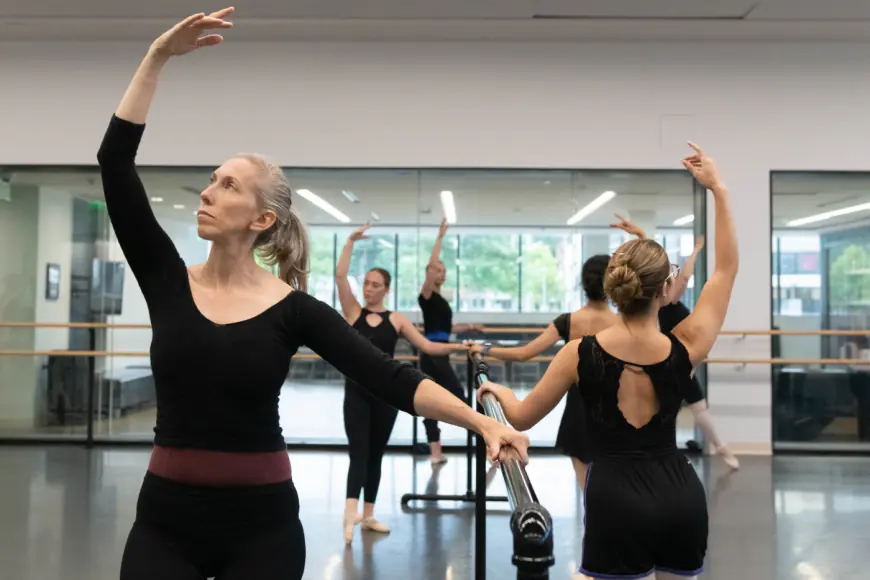At Boston Ballet class, you’re never too old to learn
What I discovered in the Foundations course is that grace and force have to be earned over, well, a lot longer than 18 weeks.

The instructions were simple: From first position, demi plié twice, grand plié once, tendu to the right into second position, repeat the pliés, tendu into third position, repeat the pliés, tendu into fourth position, repeat the pliés, then tendu back to third, repeat the pliés, then élevé into a sous-sus and remain balanced for four counts.
No, honestly, they truly were simple. Everyday, across the globe, a million ten-year-olds are running through sequences of steps like these with ease. But, three months into the Boston Ballet School’s 18-week Foundations of Ballet 1 class, the sequence was a mental and physical puzzle, an artistic Gordian Knot I had only eight bars of music to untangle.
I enrolled in Foundations of Ballet 1 last fall to learn more about the artform I’d fallen hard for. Over a decade, I expanded my arts beat at the Herald, moving slowly from Janelle Monáe and Iron Maiden to “Hamilton” and the Boston Pops to the Boston Ballet’s “Cinderella” in 2019. Nothing hit me like “Cinderella” (until Boston Ballet’s “Swan Lake” in 2022, then the company’s “My Obsession” in 2022, then “Cinderella” again in 2024, then last autumn’s “Fall Experience”).
Reviewing the 2019 performance of legendary choreographer Frederick Ashton’s 1948 vision of the fairy tale was the hardest piece of work I’d done in years. Just decoding what I saw on stage was a challenge — my reporter’s notebook was scribbled with things like, “look up what it’s called when somebody spins around a lot on stage” (it was a series of chaînés), and “find out if there’s a name for duet dance” (there is, pas de deux).
Between the furious jotting of ridiculous notes, I marveled at the sublime grace and beautiful force the dancers put forth.
What I discovered in the Foundations course is that grace and force have to be earned over, well, a lot longer than 18 weeks. Oh, and the long journey toward the two doesn’t leave a ton of room to absorb instructions if you don’t have a ten-year-old’s wonderfully spongy brain.
While my ballet vocabulary did expand over the course, it was hard to pick up the language when so much of my strength, stamina, and brainpower focused on not lurching around like oaf. Thankfully, many of my fellow students were in the same boat. The Boston Ballet’s introduction course welcomes hopefuls of all ages, abilities, experiences. And in the fun, judgement-free zone, each student received equal doses of encouragement and enthusiasm from the instructor.
What I did absorb was ballet’s governing logic: The aesthetics stand firm on the athletics. Proper posture isn’t decorative but is used to maintain balance. Foot position isn’t for show but to avoid injury. Eventually the aesthetic and athletic add up to grace and force (again, not in 18 weeks, no matter how hard an aging Gen Xer tries).
That aesthetics through athletics logic was there in principal dancer Seo Hye Han’s performance as Cinderella in 2019, even if I couldn’t see it back then. I will look for it when I watch Seo Hye Han or one of her fellow principals, Chisako Oga, Chyrstyn Fentroy, Viktorina Kapitonova or Ji Young Chae dance the role of Odette in “Swan Lake” (Feb. 27–March 16 at the Citizens Opera House). But I won’t look too hard.
I’m not afraid the magic will be lost if I can see more force than grace. Seeing through to the building blocks of any art form — ballet, Broadway theater, Iron Maiden epics — enhances the magic. But I now know concentrating too hard on any ballet sequence will put me back in front of the tangled Gordian Knot. Sometimes it’s best to not puzzle. Sometimes you should just let the sublime beauty of ballet wash over you.
For details on classes and performances, including “Swan Lake,” visit bostonballet.org.
What's Your Reaction?









































































































